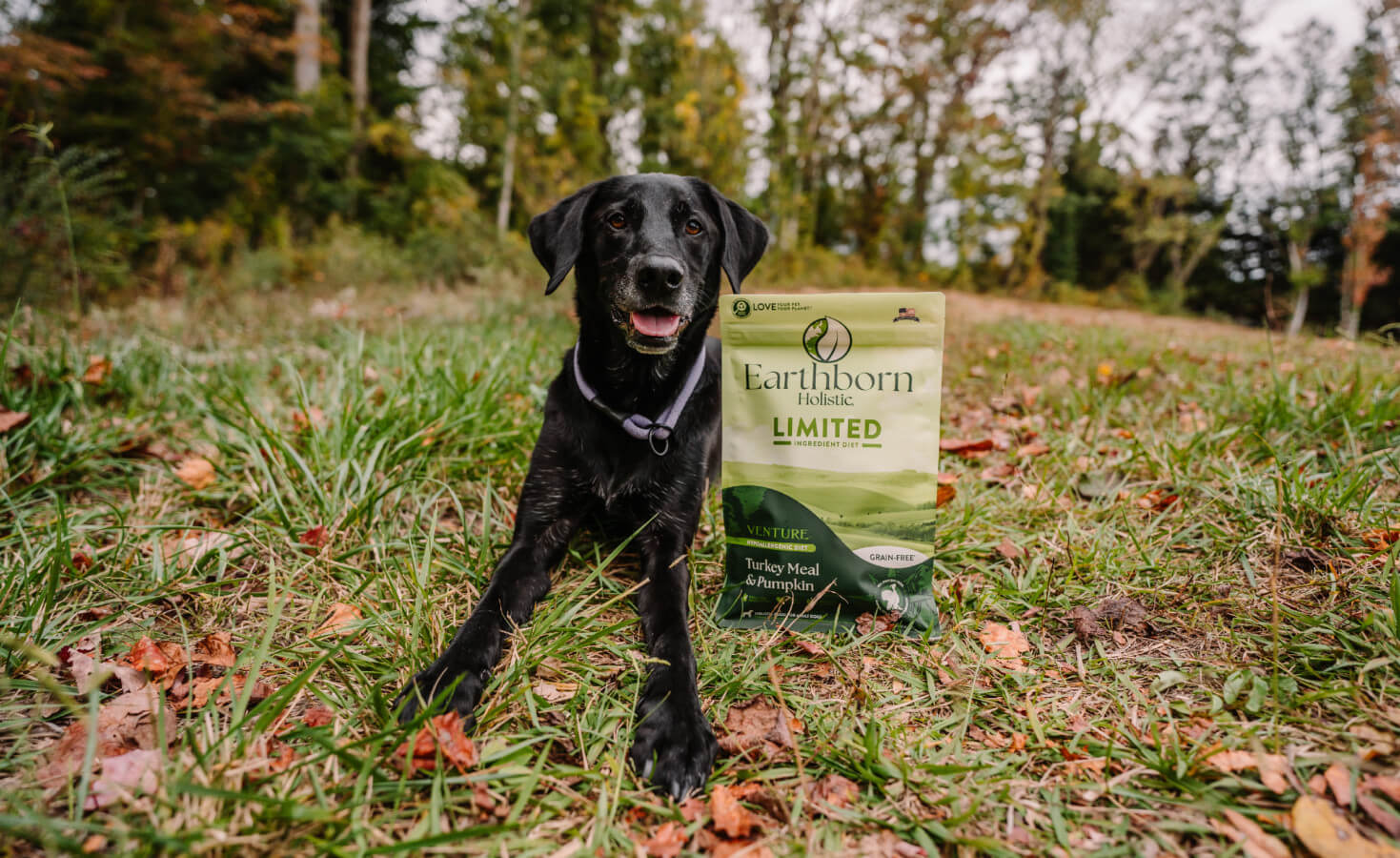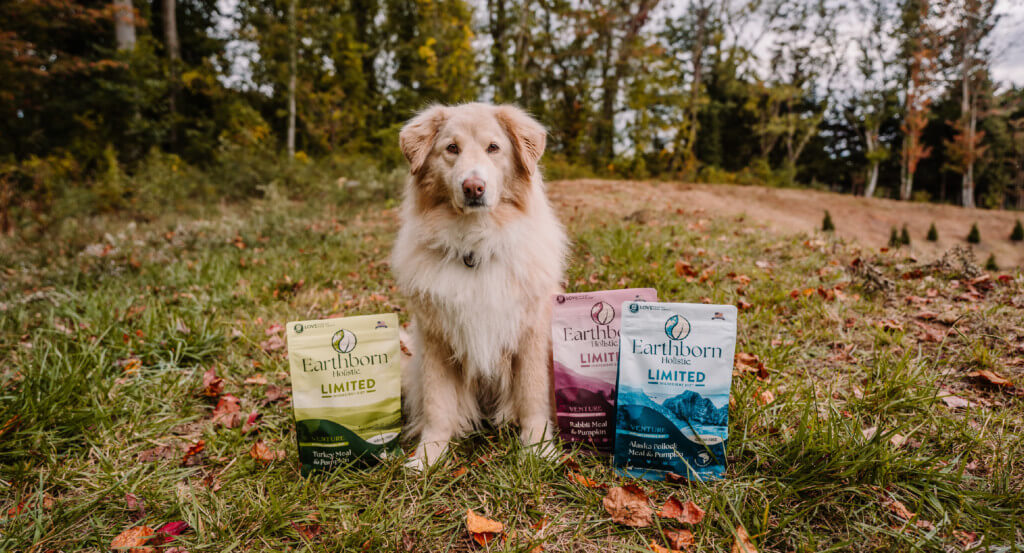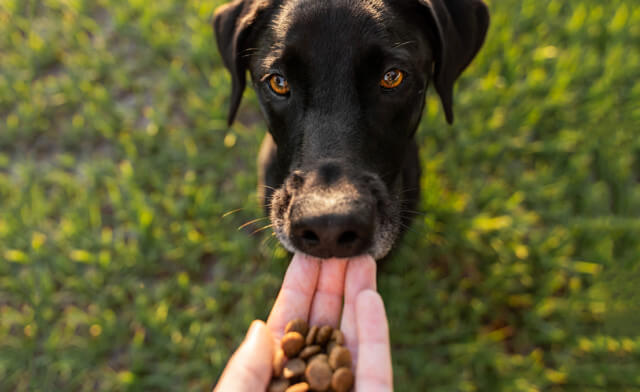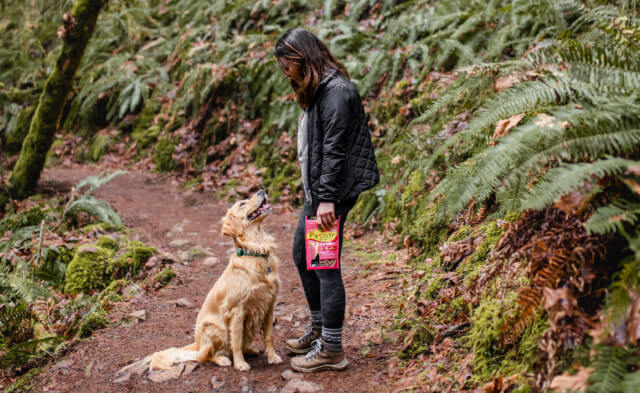Understanding Common Dog Food Allergies & The Best Diet for Dogs with Food Allergies
If you’re concerned that your dog may be allergic to their food, you’re not alone. Many pet parents wonder if their furry friend is experiencing an allergy to something in their diet. While some food allergies are more common than others, almost any ingredient has the potential to cause an allergic reaction in dogs. But the good news is that it’s possible to manage your dog’s allergies and help them feel their best.
In this article, we’ll look at some of the most common symptoms of food allergies in dogs and a few of the ingredients that are known to trigger reactions. We’ll also provide some tips on how to help a dog with food allergies and how to switch to an appropriate diet for dogs with allergies and sensitivities.

Is My Dog Allergic to Its Food?
First, let’s start with the basics. Many pet parents think their dog is allergic to their food when, in fact, they may be experiencing food intolerance or sensitivities. It’s important to understand the difference between these conditions so you can better identify what your dog is dealing with and get them the treatment they need.
Food allergies are caused by an immune reaction to a particular ingredient. When your dog eats something they’re allergic to, the immune system recognizes it as a foreign invader and produces antibodies to fight it off. This reaction can cause a range of symptoms, from mild to severe.
Dog food intolerance, on the other hand, is not an immune reaction. Instead, it’s caused by your dog’s digestive system not being able to properly process a certain ingredient. This can lead to gastrointestinal issues like diarrhea, vomiting, and gas. While food intolerance is not as serious as a food allergy, it can still be very uncomfortable for your pet.
Dog food allergy symptoms can vary depending on the severity of the allergy and the amount of the allergen that was ingested. In some cases, symptoms may be mild and only appear after your dog has eaten a large amount of the offending food. In other cases, even a small amount can trigger a severe reaction.
Some of the most common symptoms of food allergies in dogs include:
- Itching and scratching
- Hives or welts
- Red, inflamed skin
- Diarrhea
- Vomiting
- Wheezing or difficulty breathing
If you notice any of these symptoms in your dog, it’s important to take them to the vet right away. Only a professional can properly diagnose a dog’s allergic reaction to food and determine the best course of treatment.
Beef Allergies in Dogs: Finding the Best Beef-Free Food for Dogs with Allergies
Beef is a common protein source in dog food, so it’s not surprising that beef allergies are one of the most common food allergies in dogs. Beef allergy in dogs can manifest in a variety of ways, including those listed above. Other common symptoms of beef allergies in dogs include excessive licking or chewing, hair loss, hot spots, and ear infections
If you suspect your dog may be allergic to beef, the best thing you can do is talk to your veterinarian. They will likely recommend a food trial as the first step in diagnosing a food allergy. This involves switching your dog to a limited ingredient diet that does not contain any beef for at least 8-12 weeks. If the symptoms go away during this time, beef is likely the culprit.
But is ground beef good for dogs? And can dogs eat raw beef? If you feed your dog a homemade or raw diet, you may be wondering if you can still include beef in their meals. As long as your dog has not been diagnosed with a beef allergy, there’s no reason why they can’t eat raw beef or ground beef as part of their diet.
However, if your dog does have a beef allergy, it’s important to avoid all products that contain beef – including raw and ground beef – to prevent a reaction.
Dairy Allergies: Finding the Best Dairy-Free Food for Allergic Dogs
Dairy allergies are also a relatively common type of food allergy in dogs. While most people think of dairy as milk and cheese, it’s actually any food that contains milk from an animal. This includes goat’s milk, butter, and yogurt.
Symptoms of dairy allergy in dogs are similar to those of other food allergies. You may notice your dog itching, scratching, or licking excessively. They may also experience gastrointestinal issues like diarrhea, vomiting, or gas.
Dogs and dairy don’t always mix well, even if your dog isn’t allergic to it. Many dogs are lactose intolerant, which means they can’t properly digest lactose, a sugar found in milk.
If you think your dog may be lactose intolerant or allergic to dairy, talk to your veterinarian about the best way to proceed. They may recommend a food trial or other allergy testing to confirm the diagnosis.
If your dog is lactose intolerant or has a dairy allergy, it’s important to avoid all products that contain milk from any animal. This includes dairy-based dog foods as well as human foods like cheese and ice cream.

Wheat Allergies in Dogs: Trying a Grain-Free Dog Food for Allergies
Wheat allergies are another common dog food allergy. Wheat is a type of grain that’s found in many different kinds of food, including bread, pasta, cereal, and baked goods. It’s also often used as an ingredient in dog food.
A wheat allergy in dogs often presents as skin and coat symptoms like itching, scratching, red, inflamed skin, and hair loss. Your dog may also suffer from chronic ear infections or experience gastrointestinal issues.
As with other food allergies, it’s important to talk to your veterinarian if you think your dog may be allergic to wheat. They can run tests to confirm the diagnosis and recommend the best course of treatment.
It’s worth noting that gluten intolerance in dogs is different from a wheat allergy. Gluten is a protein found in wheat, rye, and barley. Some dogs may be intolerant or sensitive to gluten, but they do not have an allergy to it. However, you should still avoid feeding your dog foods that contain gluten if they are intolerant or sensitive to it.
If your dog has a wheat allergy, make sure to avoid all products that contain wheat, other grains, or gluten. This includes wheat-based dog foods as well as human foods like bread, pasta, and cereal. Your veterinarian may recommend feeding a wheat free dog food or gluten free dog food to manage wheat or grain allergy in dogs. Luckily, none of our Earthborn Holistic recipes contain any wheat!
Egg Allergies: Finding the Best Egg-Free Food for a Dog with Allergies
Eggs are found in many dog foods thanks to their high protein content. But they can also cause food allergies in some dogs. Symptoms of a dog egg allergy may include itching, redness, swelling, and hot spots on the skin. Chronic gas, diarrhea, vomiting, and other gastrointestinal issues can also be signs of an allergy to eggs.
If you notice egg allergy symptoms in your dog, make sure to consult with your veterinarian. They can help you determine whether or not your dog is allergic to eggs and recommend the best course of treatment. If your dog has an egg allergy, you’ll need to avoid all products that contain eggs – including both dog food and human food — and your vet may recommend a food for a dog with allergies to eggs.
But what about eggs for dogs in general? Can they be part of a healthy diet? The answer is yes! Eggs are a great source of protein, fatty acids, and other nutrients, and they can be a healthy addition to your dog’s diet. However, most veterinarians do not recommend raw eggs for dogs. This is because raw eggs may contain bacteria such as salmonella, which can make your dog sick.
If you want to feed your dog eggs, cook them thoroughly before giving them to your pup. You can scramble them, hard boil them, or bake them into a homemade dog treat – just make sure they’re cooked all the way through. It’s also best to cook eggs without any additional ingredients like butter or oil. And of course, make sure to let the eggs cool completely before giving them to your dog.
Chicken Allergies: Trying a Chicken-Free Diet for a Dog with Chicken Allergies
While most dogs can tolerate chicken without any problems, some may develop an allergy to this common protein source. Symptoms of a chicken allergy in dogs can vary from mild to severe and may include an itchy stomach, excessive licking, hair loss, and gastrointestinal problems.
If you suspect that your dog has a chicken allergy, it is important to work with your veterinarian to develop a treatment plan. This may involve switching to a chicken-free dog food and providing them with supplements or other forms of treatment.
So, what’s the best dog food for chicken allergies in dogs? Well, there are a few things you’ll want to look for. Aside from being free from chicken and chicken by-products, the food should contain a limited number of ingredients to reduce the risk of an allergic reaction.
It’s also important to choose a food that’s complete and balanced to ensure that your dog is getting all the nutrients they need. A high-quality limited ingredient dog food is usually the best dog food for chicken allergy.
Lamb Allergies: Trying a Lamb-Free Diet for Dogs with Allergies
Many people are surprised to learn that their dog can be allergic to lamb. After all, lamb is a relatively uncommon ingredient in dog food. However, lamb allergies can and do occur in dogs, leading to a range of different symptoms.
The most common symptom is itching and dog dry skin, which can lead to excessive scratching, chewing, and dogs licking paws. This can often result in bald spots, red skin, and even hot spots. Lamb allergies can also cause gastrointestinal problems, such as diarrhea and vomiting.
If you think your dog may be allergic to lamb, it’s important to talk to your veterinarian. They can help you figure out the best course of action for your pup and help you determine if a limited ingredient diet for dogs with allergies to lamb is the best option.
Finally, it’s important to note that lamb is a novel protein source for many dogs. This means that lots of dogs have never been exposed to it before. So, is lamb good for dogs with allergies? The answer is, that it depends.
If your dog has never had any problems with other types of protein, then lamb may be a good option for them. However, if your dog is allergic to other proteins like chicken or beef, then they may also be allergic to lamb.
Soy Allergies
The final allergen on our list is soy. Like wheat, soy is a common ingredient in many different kinds of food, including both human and dog food. Soy allergies in dogs are relatively common and can cause a range of different symptoms.
The most common symptom of a soy allergy is dog itchy skin. If your dog is itching more than usual, it could be a sign that they’re allergic to soy. Other common symptoms include vomiting, diarrhea, and loss of appetite.
If you suspect that your dog has a soy allergy, the best thing to do is to take them to the vet. They will likely recommend eliminating soy from your dog’s diet and may also prescribe medication to help relieve the symptoms.
Your veterinarian may also recommend a soy free dog food to help your dog avoid an allergic reaction. With some careful management, most dogs with soy allergies can live happy and healthy lives.

How to Help Your Dog With a Limited Ingredient Dog Food for Allergies
Now that we’ve covered some of the most common ingredients that can trigger allergies in dogs, let’s talk about how you can help your pup if they’re dealing with a food allergy.
The first and most important step is to talk to your veterinarian. They will be able to help you figure out which ingredients are causing the allergic reaction and develop a treatment plan that’s right for your dog.
As we touched on earlier, a food trial (also known as a dog elimination diet) is often the best way to identify which ingredients are causing the problem. This involves switching your dog to a limited ingredient diet and slowly adding new ingredients back in one at a time to see if there’s a reaction.
A limited ingredient dog food for allergies should contain a novel protein that your dog hasn’t eaten before. This could be anything from pork to rabbit or duck. It’s also important to select a food that contains a different type of carbohydrate than your dog is used to eating. For example, if they typically eat a food that contains wheat, you may want to switch to a food that contains brown rice instead.
Choosing the right type of food is crucial, so work with your veterinarian to select a dog food that helps with allergies. Once you’ve selected the food, it’s vital to stick with it for at least 8-12 weeks to give your dog’s system time to adjust.
In some cases, switching to a limited ingredient diet may not be enough to control the symptoms of an allergy. In these cases, your veterinarian may recommend additional treatment, such as medication or supplements.
No matter what course of treatment you decide on, it’s important to be patient and consistent. It can take some time for your dog’s system to adjust, but with the right care, most dogs with food allergies can adapt and live a normal, healthy life.
The Best Food for Dogs with Food Allergies
If your dog has been diagnosed with a food allergy or food intolerance, you may be wondering what the best type of food is to feed them. The good news is that there are a variety of dog food options available that can help your pup manage their allergies. And with a little trial and error, you should be able to find one that works for your pup.
One type of food to consider is limited ingredient dog food like our Limited Ingredient Diet recipes. These foods contain fewer ingredients than traditional dog food, making them easier to digest and less likely to trigger an allergic reaction.
Another excellent option is wet dog food for sensitive stomachs, like Lily’s Gourmet Buffet™ in Sauce. The lip-licking savory lamb, limited ingredient wet grain-free dog food is specially formulated for dogs with sensitivities to certain proteins or carbohydrates.
This type of food is easy for your dog’s body to break down and can be a good option for pups with digestive issues. Since skin problems are also common in dogs with allergies, it can be beneficial to feed sensitive skin and stomach dog food like Coastal Catch.
Lastly, if your dog has a severe allergy, you may need to consult with a veterinary nutritionist to create a custom diet plan. In general, the best type of food for a dog with allergies is one that is limited in ingredients and easy to digest.
Switching to a New Dog Food for Dogs with Food Allergies
If your dog has food allergies, switching dog food is one of the best ways to help manage their condition. But, it’s important to do so slowly and carefully to avoid any adverse reactions. Changing dog food too quickly symptoms can include stomach upset, diarrhea, and other digestive issues.
So, how can you switch your dog’s food without causing problems? The key is to do it slowly, over the course of 7-10 days. To start, mix your dog’s new food with their old food, gradually increasing the amount of new food while decreasing the amount of old food. By the end of the week, you can stop mixing dog food as your pup should be eating only the new food.
Here are some general guidelines for the amount of food to feed your dog during the transition over a 10-day period:
- Days 1-3: 75% old food, 25% new food
- Days 4-6: 50% old food, 50% new food
- Days 7-9: 25% old food, 75% new food
- Day 10 onward: 100% new food
Of course, every dog is different, so it’s important to discuss the best transition plan with your veterinarian. They can help you determine the right amount of food to feed your dog based on factors such as age, weight, and overall health.
If you notice any digestive issues during the transition, slow down the process and add a little more of the old food back in. And if your dog has any adverse reactions during the transition period, such as vomiting or diarrhea, contact your veterinarian right away.
Once you’ve made the switch, be sure to monitor your dog for any signs of discomfort or illness. Some dogs can take a few weeks to fully adjust to their new diet, so it’s important to be patient and give them time to adapt.
If you notice any changes in your dog’s health or behavior after switching their food, contact your veterinarian. They can help you troubleshoot the issue and determine whether your dog’s food is the cause and if switching to a dog food for dogs with food allergies may be a better option.
What is the Best Diet for Dog with Allergies? Top 7 Takeaways
We hope you enjoyed this article about common dog food allergies and found it useful and informative. To wrap things up, here’s a quick list of the top 7 takeaways to keep in mind:
- Food allergies and intolerances are relatively common in dogs and can cause a variety of symptoms, including digestive issues, skin problems, and respiratory distress.
- Some of the most common allergens in dog food include beef, dairy, wheat, eggs, chicken, lamb, and soy.
- If you suspect your dog has a food allergy or intolerance, it’s important to consult with your veterinarian. They can perform a dog food test to confirm the diagnosis and develop a treatment plan.
- A food trial or elimination diet is often the best way to identify which ingredients your dog is allergic to. This involves switching your dog to a new food and eliminating all other sources of potential allergens.
- If your dog has food allergies, switching to a new dog food is one of the best ways to help manage their condition. But, it’s important to do so slowly and carefully to avoid any adverse reactions.
- There are a variety of specialty dog foods available for dogs with allergies, including limited ingredient dog food, wet dog food for sensitive stomachs, and sensitive skin and stomach dog food. Work with your vet to find the best food for your dog’s individual needs.
- Monitor your dog closely after changing their food, and be sure to contact your veterinarian if you notice any changes in their health or behavior.
Does your dog have seasonal allergies caused by pollen, dust, or other environmental triggers? Check out Earthborn’s Ultimate Guide to Springtime Allergies and Safety for some practical tips to help you keep your pup safe and comfortable during allergy season.




